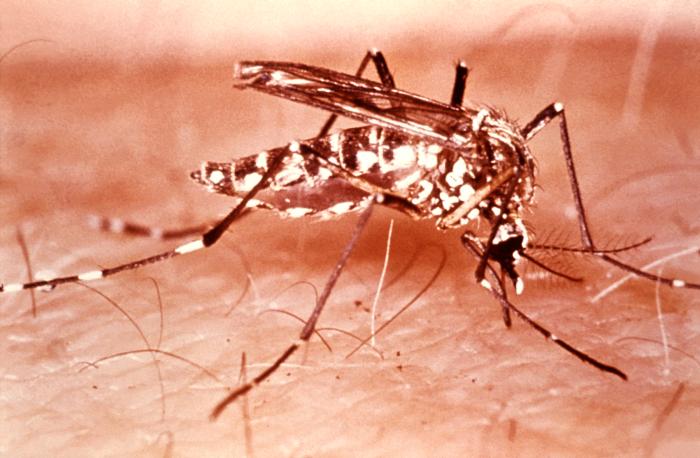Yellow fever pathophysiology: Difference between revisions
No edit summary |
No edit summary |
||
| Line 7: | Line 7: | ||
[[Image:Aedes aegypti mosquito2.jpg|left|thumb|150px|The female ''[[Aedes aegypti]]'' mosquito on a human host, about to obtain a blood meal]] | [[Image:Aedes aegypti mosquito2.jpg|left|thumb|150px|The female ''[[Aedes aegypti]]'' mosquito on a human host, about to obtain a blood meal]] | ||
Yellow fever is caused by an [[arbovirus]] of the family [[Flaviviridae]], a positive single-stranded [[RNA]] virus. Human infection begins after deposition of viral particles through the skin in infected [[arthropod]] [[saliva]]. The mosquitos involved are ''Aedes simpsaloni'', ''A. africanus'', and ''[[Aedes aegypti|A. aegypti]]'' in Africa, the ''Haemagogus'' genus in South America, and the ''Sasbethes'' genera in France. | Yellow fever is caused by an [[arbovirus]] of the family [[Flaviviridae]], a positive single-stranded [[RNA]] virus. Human infection begins after deposition of viral particles through the skin in infected [[arthropod]] [[saliva]]. The mosquitos involved are ''Aedes simpsaloni'', ''A. africanus'', and ''[[Aedes aegypti|A. aegypti]]'' in Africa, the ''Haemagogus'' genus in South America, and the ''Sasbethes'' genera in France. | ||
Yellow fever is frequently severe but more moderate cases may occur as the result of previous infection by another flavivirus. After infection the virus first replicates locally, followed by transportation to the rest of the body via the [[lymphatic system]].{{cite book | author = Ryan KJ; Ray CG (editors) | title = Sherris Medical Microbiology | edition = 4th ed. | publisher = McGraw Hill|year = 2004|id = ISBN 0-8385-8529-9 }}</ref> Following systemic lymphatic infection the virus proceeds to establish itself throughout organ systems, including the heart, kidneys, [[adrenal gland]]s, and the [[parenchyma]] of the liver; high viral loads are also present in the blood. | Yellow fever is frequently severe but more moderate cases may occur as the result of previous infection by another flavivirus. After infection the virus first replicates locally, followed by transportation to the rest of the body via the [[lymphatic system]].{{cite book | author = Ryan KJ; Ray CG (editors) | title = Sherris Medical Microbiology | edition = 4th ed. | publisher = McGraw Hill|year = 2004|id = ISBN 0-8385-8529-9 }}</ref> Following systemic lymphatic infection the virus proceeds to establish itself throughout organ systems, including the heart, kidneys, [[adrenal gland]]s, and the [[parenchyma]] of the liver; high viral loads are also present in the blood. Necrotic masses ([[Councilman body|Councilman bodies]]) appear in the [[cytoplasm]] of [[hepatocyte]]s.<sup>,</sup><ref name=Quaresma_2006>{{cite journal | author=Quaresma JA, Barros VL, Pagliari C, Fernandes ER, Guedes F, Takakura CF, Andrade HF Jr, Vasconcelos PF, Duarte MI | title=Revisiting the liver in human yellow fever: virus-induced apoptosis in hepatocytes associated with TGF-beta, TNF-alpha and NK cells activity | journal=Virology | year=2006 | pages=22-30 | volume=345 | issue=1 | id= PMID 16278000 }}</ref> | ||
There is a difference between disease outbreaks in rural or forest areas and in towns. Disease outbreaks in towns and non-native people are usually more serious. | There is a difference between disease outbreaks in rural or forest areas and in towns. Disease outbreaks in towns and non-native people are usually more serious. | ||
Revision as of 19:51, 2 February 2012
|
Yellow fever Microchapters |
|
Diagnosis |
|---|
|
Treatment |
|
Treatment |
|
Yellow fever pathophysiology On the Web |
|
American Roentgen Ray Society Images of Yellow fever pathophysiology |
|
Risk calculators and risk factors for Yellow fever pathophysiology |
Editor-In-Chief: C. Michael Gibson, M.S., M.D. [1]
Overview
Pathogenesis

Yellow fever is caused by an arbovirus of the family Flaviviridae, a positive single-stranded RNA virus. Human infection begins after deposition of viral particles through the skin in infected arthropod saliva. The mosquitos involved are Aedes simpsaloni, A. africanus, and A. aegypti in Africa, the Haemagogus genus in South America, and the Sasbethes genera in France. Yellow fever is frequently severe but more moderate cases may occur as the result of previous infection by another flavivirus. After infection the virus first replicates locally, followed by transportation to the rest of the body via the lymphatic system.Ryan KJ; Ray CG (editors) (2004). Sherris Medical Microbiology (4th ed. ed.). McGraw Hill. ISBN 0-8385-8529-9.</ref> Following systemic lymphatic infection the virus proceeds to establish itself throughout organ systems, including the heart, kidneys, adrenal glands, and the parenchyma of the liver; high viral loads are also present in the blood. Necrotic masses (Councilman bodies) appear in the cytoplasm of hepatocytes.,[1] There is a difference between disease outbreaks in rural or forest areas and in towns. Disease outbreaks in towns and non-native people are usually more serious.
References
- ↑ Quaresma JA, Barros VL, Pagliari C, Fernandes ER, Guedes F, Takakura CF, Andrade HF Jr, Vasconcelos PF, Duarte MI (2006). "Revisiting the liver in human yellow fever: virus-induced apoptosis in hepatocytes associated with TGF-beta, TNF-alpha and NK cells activity". Virology. 345 (1): 22–30. PMID 16278000.